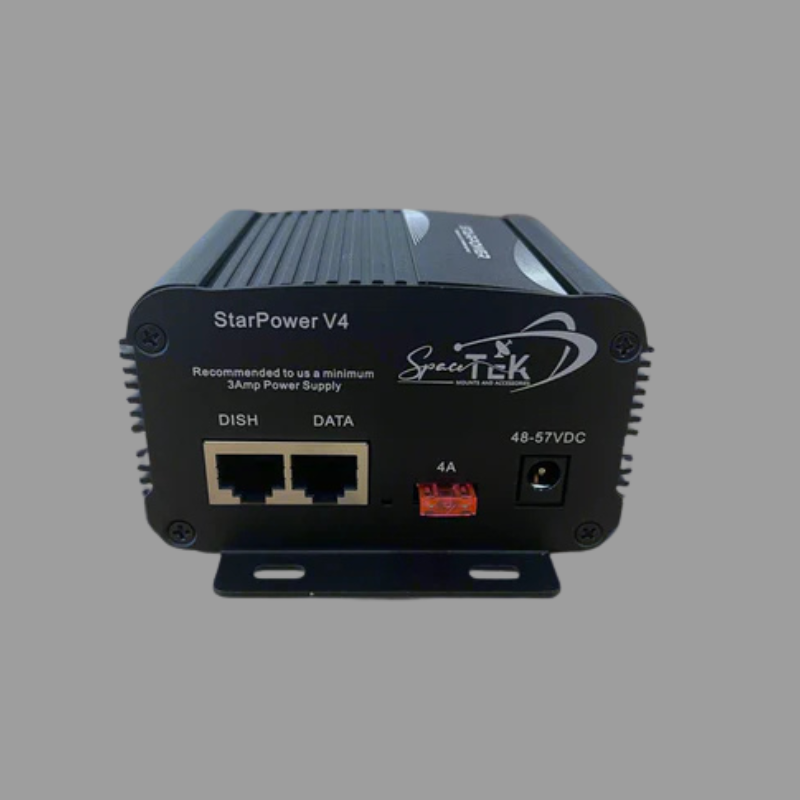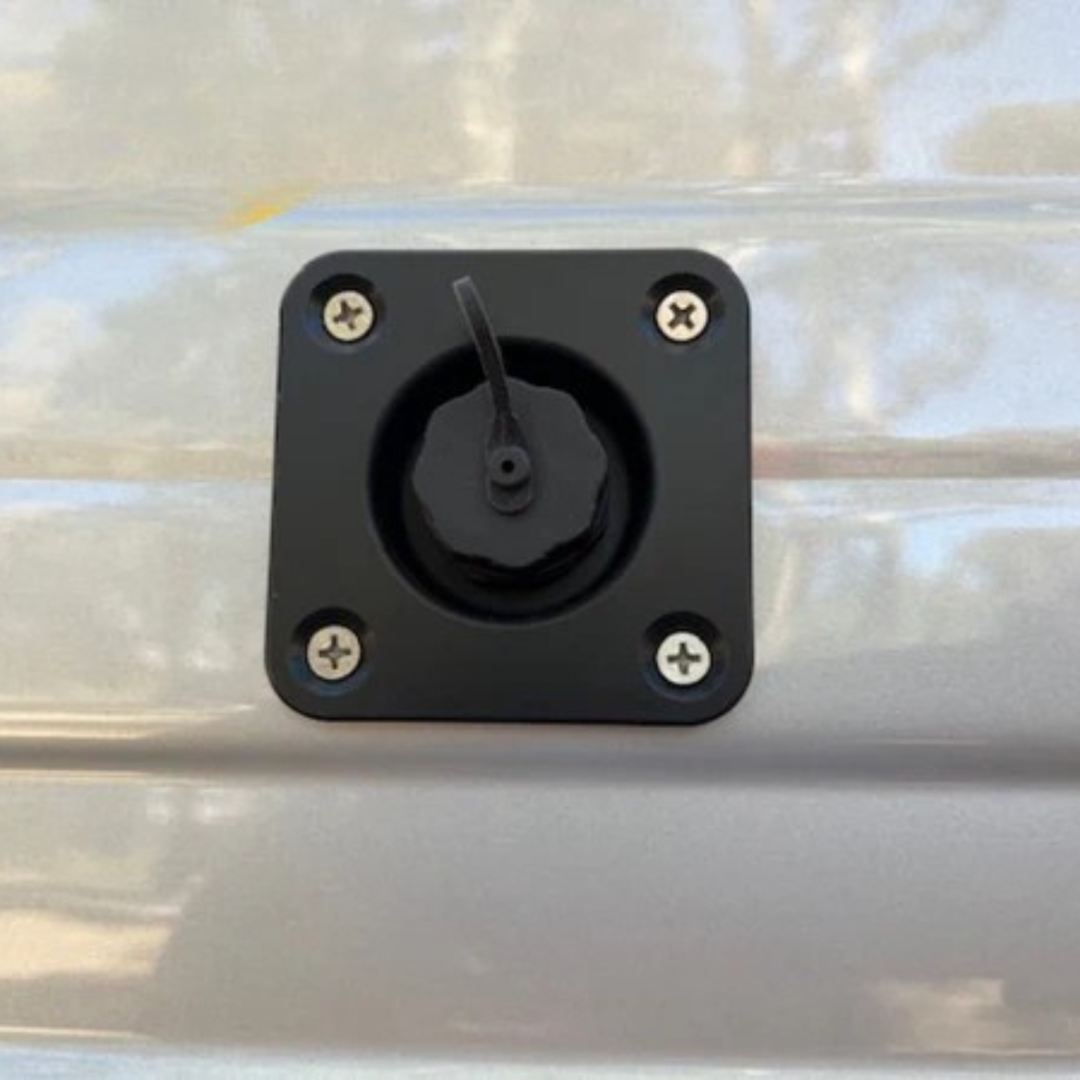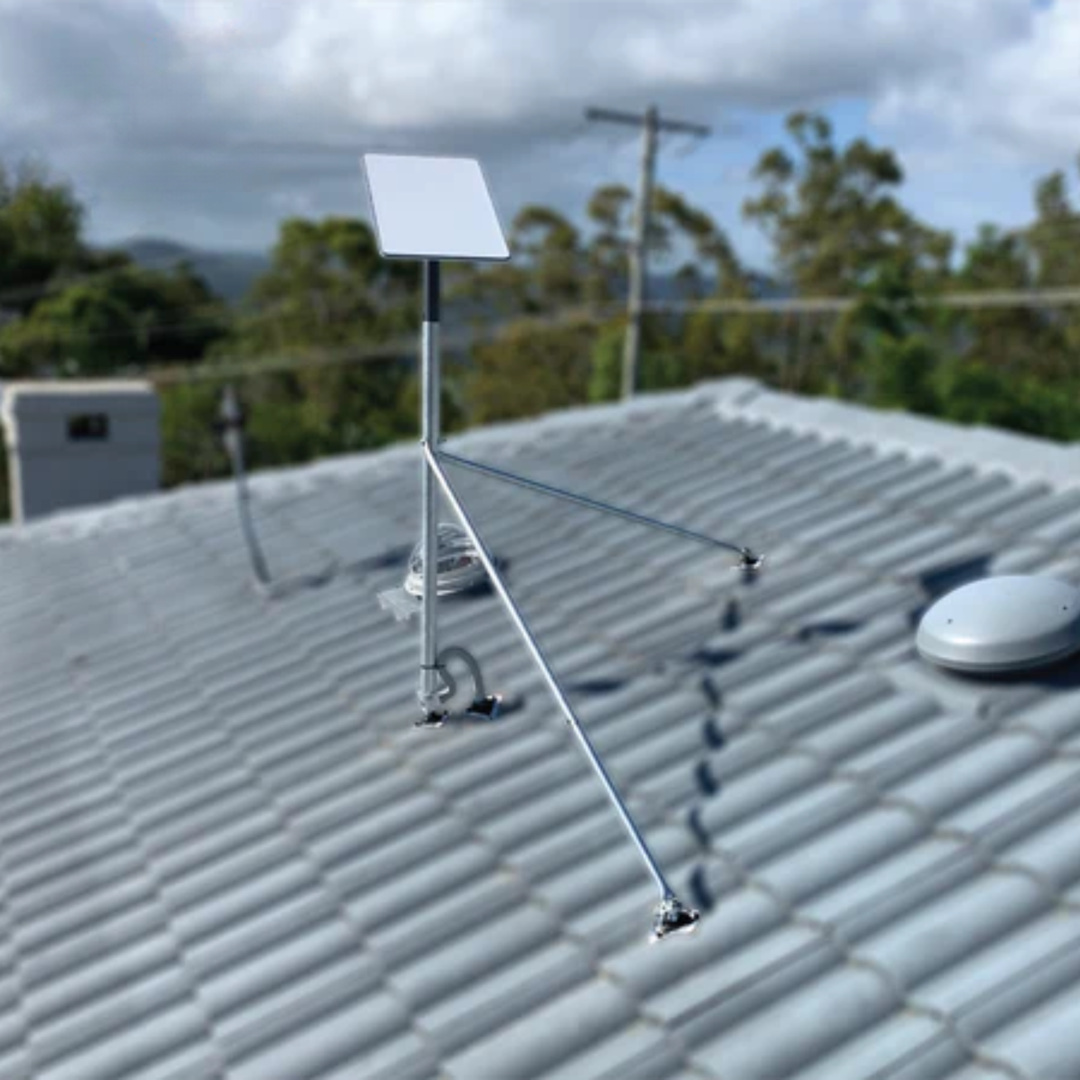Why Starlink Roam DC Power Is Essential for Australian Remote Users
Starlink roam dc power solutions are changing how Australians stay connected in remote areas, offering a more efficient alternative to traditional AC power setups. Here's what you need to know:
- Power Efficiency: DC power saves up to 29% energy compared to AC inverter setups
- Voltage Range: Mini dishes accept 12-48V DC; Standard dishes require 56V DC
- Consumption: Mini draws ~40W at startup, ~25W active, ~12.5W idle
- Australian Benefits: Perfect for caravan parks, remote stations, and off-grid communities
Living off-grid or travelling around Australia's vast landscape means every watt counts. Traditional Starlink setups require converting your 12V battery power to 240V AC, then back to DC - a process that wastes precious energy and drains your batteries faster.
Remote communities across Australia are finding that direct DC power solutions eliminate these conversion losses entirely. Whether you're running a cattle station in the Kimberley, exploring the Nullarbor in a caravan, or providing internet to a remote mining camp, starlink roam dc power systems extend your connectivity time while reducing the strain on your battery bank.
The research shows impressive results: users report power savings of 15-29% when switching from AC inverter setups to direct DC power. For a system drawing 40W, that's potentially 12 extra watts available for other essential equipment - or simply longer runtime between charges.
I'm Aaron Wroblewski, founder of SpaceTek Australia, and I've spent over 25 years helping Australians solve connectivity challenges in remote locations. Through extensive field testing across diverse Australian conditions, I've seen how proper starlink roam dc power solutions can make the difference between staying connected and losing communication when you need it most.
What Is Starlink Roam & Why DC Matters
Starlink Roam has revolutionised how Australians stay connected while on the move. Unlike residential Starlink service that's locked to your home address, this mobility plan lets you pack up your rectangular dish and head anywhere within Australia's coverage zones. Whether you're chasing the perfect camping spot along the Great Ocean Road or running a remote cattle station in the Pilbara, starlink roam dc power solutions ensure you stay connected without compromise.
The beauty of Roam lies in its in-motion capability - you can actually stream your favourite shows while driving through the Red Centre or jump on a video call from a secluded beach camp. This flexibility has made it incredibly popular among van life enthusiasts, grey nomads, and anyone who refuses to let geography dictate their internet quality.
But here's where things get interesting for off-grid users. Most caravans, motorhomes, and remote installations run on 12V or 24V DC battery systems - the same power that comes from your solar panels or alternator. Standard Starlink setups force you to convert this precious DC power to 240V AC using an inverter, only for the Starlink power supply to convert it straight back to DC. It's like filling a bucket with a hole in the bottom.
Starlink in Australia has become essential infrastructure for remote communities where traditional internet simply doesn't reach. From mining camps in Western Australia to research stations in the Northern Territory, reliable connectivity isn't just convenient - it's critical for safety, communication, and keeping businesses running.
The power conversion losses in traditional setups are substantial. Every time you convert DC to AC and back again, you're losing energy as heat. For Starlink for Remote Australia users running on limited battery capacity, this inefficiency can mean the difference between staying connected and losing communication when you need it most.
Starlink Roam vs Residential Service
The fundamental difference between Roam and residential service boils down to freedom. Residential Starlink creates a virtual fence around your registered address - step outside that boundary and you're offline. Roam smashes that fence, letting you roam across Australia's vast coverage zones without missing a beat.
Starlink for Remote Communities particularly benefits from Roam's pause feature. Seasonal workers, research teams, and emergency services can activate their service when needed and pause it during downtime. This flexibility makes it cost-effective for users who don't need year-round connectivity.
The roaming data allowances vary by plan, but most Australian users find the standard packages provide plenty of data for essential communications, streaming, and work requirements. The coverage zones are generous too - you can travel from Perth to Darwin or Sydney to Cairns without losing signal.
Advantages of Direct DC Power
Direct DC power delivery transforms your Starlink experience, especially when you're running on batteries. The efficiency gains are remarkable - research shows starlink roam dc power systems can slash power consumption by up to 29% during normal operation. That's not just numbers on paper; it translates to significantly longer battery runtime when you're days away from the nearest power source.
Eliminating inverter losses removes the constant 9-11W idle draw that many inverters consume even when they're not actively powering equipment. This silent operation also reduces electromagnetic interference that can affect sensitive electronics in your setup - no more annoying humming from inverters running 24/7.
The lower idle draw becomes particularly valuable when your Starlink system drops to its 12.5W idle state overnight. Without inverter losses eating into your battery bank, every watt saved extends your off-grid capability. This efficiency is crucial for Starlink installation Australia projects in remote locations where power is precious.
For comprehensive guidance on maximising these efficiency gains, SpaceTek's DC power solutions provide detailed technical information to help you get the most from your system.
Starlink Roam DC Power Basics
Getting your starlink roam dc power setup right from the start makes all the difference between a system that just works and one that keeps you connected reliably across Australia's diverse conditions. After years of helping Aussie users optimise their mobile internet setups, I've seen how understanding the power fundamentals can save you headaches down the track.
The voltage requirements vary quite a bit depending on which Starlink hardware you're running. The Mini dish is beautifully flexible, accepting anything from 12V to 48V DC - perfect for plugging straight into most caravan or motorhome battery systems. Standard dishes are a bit more particular, needing 56V DC input, which means you'll need a proper step-up solution. The High-Performance dishes are the power-hungry cousins of the family, capable of drawing up to 320W during peak operation - definitely something to factor into your power budget.
When your system first boots up, expect it to draw around 40W for those initial few minutes while it finds satellites and sorts itself out. It's a bit like your morning coffee routine - needs that initial surge to get going properly. Once it's settled into normal operation, you're looking at roughly 25W for active internet use on a Mini dish, with the larger dishes proportionally higher.
The beauty of a well-designed DC system becomes apparent during those quiet periods. When you're not actively browsing or streaming, power consumption drops to around 12.5W idle - just enough to maintain those satellite connections without draining your batteries unnecessarily.
Understanding Starlink Roam DC Power Requirements
The Mini dish's 12-48V range makes it genuinely plug-and-play for most Australian mobile setups. Whether you're running a 12V system in an older caravan or a modern 24V setup in a luxury motorhome, the Mini adapts beautifully. That little 5.5mm barrel connector keeps things simple - no fancy adapters or complicated wiring schemes required.
Standard dishes step things up with their 56V DC requirement, delivered through a specialised Power over Ethernet setup. This higher voltage actually works in your favour for longer cable runs, reducing current and minimising voltage drop issues. Just remember that this isn't your standard PoE - Starlink uses its own pinout configuration.
Fuse sizing needs to account for those startup surges - typically 30A for 12V systems, dropping to 15A for 24V setups. Wire gauge becomes critical here, especially in 12V systems where higher currents flow. For shorter runs, 8-10 AWG copper wire handles most situations well, but don't skimp on wire size for longer distances between your battery bank and the dish.
The XT60 connector has become something of a standard in the DC power world, and for good reason. It handles the current requirements reliably while providing a secure, weatherproof connection that won't let you down when you're camped beside a remote beach or parked up in the high country.
Typical Power Consumption Figures
That 40W boot sequence might seem like a lot when you're watching your battery monitor, but it's over quickly. Think of it as the system's way of introducing itself to the satellites overhead - a brief handshake that establishes the connection properly. This initial surge typically lasts just 2-3 minutes, then settles into more reasonable consumption levels.
Normal browsing and email activities sit comfortably around that 25W mark for Mini dishes. You'll find this covers everything from checking weather forecasts to video calls with family back home. Even light streaming sits within this range, making it perfect for those evening Netflix sessions under the stars.
The 12.5W idle consumption is where DC power really shines. Your system stays ready to receive calls or messages without that constant inverter drain eating away at your battery bank. It's particularly valuable for those extended stays in remote locations where every watt counts.
Snow melt functionality can push consumption up to 100W or more, though this is more relevant for our alpine region travellers or those winter trips to the Snowy Mountains. The system automatically detects when heating is needed to maintain signal quality, but it's worth factoring into your power calculations if you're planning cold-weather trips.
Seasonal variations do affect consumption, with colder conditions generally requiring more power for optimal operation. Most Australian users find summer operation more efficient, while winter trips - particularly in Tasmania or the alpine regions - may see slightly higher average consumption due to environmental factors.
Choosing Your DC Solution: Meet StarPower V4
After years of testing across Australia's challenging conditions - from the scorching heat of the Pilbara to the salt-laden air of coastal Queensland - we've developed something special. The StarPower V4 represents our answer to the unique challenges that Australian starlink roam dc power users face every day.
What makes the StarPower V4 different? It's designed specifically for the Australian environment where extreme temperatures, corrosive conditions, and demanding mobile applications push equipment to its limits. Rather than offering multiple incompatible solutions that leave users confused, we've created a single platform that adapts to virtually any Starlink configuration you might encounter.
The beauty of universal compatibility means your StarPower V4 works seamlessly whether you're running a Gen 1 system from the early days, a current Gen 3 setup, or the compact Mini dish that's perfect for caravan life. This future-proofing ensures your investment remains valuable even when you upgrade your Starlink hardware down the track.
One feature that consistently impresses users is the router bypass capability. We've all heard the stories - Starlink routers failing in remote locations, leaving users stranded without connectivity. The StarPower V4 allows direct dish powering while integrating superior third-party networking equipment, turning a potential disaster into a simple workaround.
Safety hasn't been an afterthought in our design process. The system includes comprehensive protection against reverse polarity connections, overvoltage conditions, and overcurrent situations. Clear installation instructions and safety warnings help prevent those expensive mistakes that can occur during setup.
Why StarPower V4
The plug-and-play design eliminates the guesswork that often frustrates DIY installers. Each StarPower V4 system undergoes comprehensive bench testing in our workshop before it leaves our facility, ensuring reliable operation from the moment you connect it to your battery system.
Our 57V power pack provides the stable, clean power delivery that Starlink systems demand. The regulated output prevents those annoying voltage fluctuations that can cause connectivity dropouts or equipment damage - particularly important in mobile applications where battery voltage varies significantly with charge state and temperature.
The 30V Mini support ensures compatibility with Starlink's newest hardware while maintaining all the efficiency advantages of direct DC power. The included PoE splitter delivers stable power delivery that's been optimised specifically for mobile network setups where reliability matters most.
XT60 connectors provide secure, weatherproof connections that withstand the constant vibration and environmental challenges of mobile installations. These automotive-grade connectors ensure reliable power delivery even when you're bouncing down corrugated tracks or facing coastal weather conditions.
Our field testing across Australia's diverse environments has validated the StarPower V4's performance from tropical Far North Queensland to the arid expanses of the Great Western Woodlands. This real-world validation gives us confidence in recommending the system for any Australian application, whether you're running a remote station, exploring in a caravan, or providing connectivity to an off-grid community.
Installing StarPower V4 Step-by-Step
Component mounting requires a stable, well-ventilated location that's protected from direct weather exposure. Most users find success installing the system in a battery compartment or dedicated electronics enclosure, ensuring adequate airflow for heat dissipation during those hot Australian summers.
The XT60 connection follows standard automotive practices - red for positive, black for negative, with secure crimping and heat-shrink protection. The polarised connectors prevent reverse connection, but it's always wise to verify polarity with a multimeter before applying power to avoid any unpleasant surprises.
Polarity verification prevents equipment damage and ensures safe operation. Use a quality multimeter to confirm positive and negative connections match your battery system's configuration before energising the circuit. This simple step can save you from costly mistakes and potential safety hazards.
Fuse installation should occur as close to the battery positive terminal as possible, using appropriately rated fuses for your system voltage. 12V systems typically require 30A fuses, while 24V systems can use 15A protection. Don't skimp on fuse quality - a good fuse is cheap insurance against electrical faults.
Weather sealing becomes critical in mobile applications where components face constant vibration and environmental exposure. Use marine-grade sealants and ensure all connections remain dry and corrosion-free. Australian conditions can be particularly harsh on electrical connections, so extra attention to weatherproofing pays dividends.
More info about DC power supply installation provides detailed guidance on proper installation techniques that we've refined through years of Australian field experience.
Best Practices for Installing Starlink Roam on DC in Australia
Australia's harsh climate throws some serious challenges at starlink roam dc power installations. From the cyclone-lashed coasts of Queensland to the scorching heat of the Red Centre, your system needs to be bulletproof to survive what Mother Nature dishes out.
When cyclone season arrives, your Starlink setup faces winds that can exceed 200km/h. Secure mounting isn't just recommended - it's essential for survival. The dish and all supporting electronics need mounting systems that can handle these extreme forces without compromising your connection when you need it most.
Heat management becomes absolutely critical when ambient temperatures regularly hit 45°C and beyond. I've seen electronic components fail spectacularly when installers mount them in unventilated battery boxes or near exhaust systems. Your starlink roam dc power components need breathing room and protection from direct heat sources.
The Australian sun is particularly brutal on inferior materials. UV radiation degrades cheap plastics and rubber seals within months, turning what seemed like a bargain into an expensive lesson. Marine-grade materials and UV-resistant components are worth every extra dollar when you're dealing with Australia's intense solar radiation.
Rust resistance becomes non-negotiable near the coast. Salt spray accelerates corrosion faster than most people realise, and I've seen installations fail within a year when installers cut corners on hardware quality. Every bolt, bracket, and electrical connection needs to be specified for marine environments.
The vibration and dynamic loads in mobile applications create unique stresses that static installations never face. Road vibration, wind buffeting while driving, and sudden stops all combine to create forces that can damage inadequately secured equipment. Your mounting system needs to account for these real-world conditions.
Integrating solar power is a smart choice in Australia’s sunny climate, but keep in mind that weather and seasonal changes can impact how much energy you generate. To keep your system running reliably, size your solar panels and batteries to handle several days of low sunlight, ensuring you stay connected even through cloudy spells.
Battery monitoring prevents the expensive mistake of over-discharging your battery bank. Modern lithium systems include sophisticated management, but additional monitoring provides valuable insights into system performance and helps prevent costly battery damage.
Remote communities often operate days or weeks away from technical support, making reliable installation and robust system design absolutely essential. Your system must operate reliably with minimal maintenance for extended periods when the nearest technician is hundreds of kilometres away.
Troubleshooting Common Starlink Roam DC Power Issues
Voltage sag represents one of the most common issues we encounter in field installations. When your battery voltage drops under load, Starlink equipment can shut down or operate erratically. This typically happens with undersized battery banks or poor electrical connections that create resistance in the power delivery path.
The solution involves checking all electrical connections for corrosion or looseness, and ensuring your battery bank has adequate capacity for your power requirements. A quality multimeter becomes your best friend for diagnosing these issues before they leave you without connectivity.
EMI noise from cheap DC-DC converters can wreak havoc with Starlink's sensitive electronics. Poor-quality converters create electrical interference that forces Ethernet connections to negotiate at reduced speeds, dramatically affecting your internet performance. The frustration of having full satellite signal but slow speeds often traces back to power supply quality.
Investing in high-quality converters with proper filtering eliminates these issues completely. The extra cost pays for itself through reliable operation and optimal performance.
Grounding problems create multiple headaches from electrical noise to genuine safety hazards. Proper grounding ensures stable operation and protects against electrical faults that could damage expensive equipment or create dangerous conditions for users.
Firmware updates demand a rock-solid, uninterrupted power supply. If power drops out during an update, it can corrupt your Starlink Roam, sometimes leading to a factory reset or even full replacement. That’s why dependable Starlink Roam DC power is essential for keeping your system healthy and up-to-date.
Latest research on DIY fixes provides comprehensive troubleshooting guidance for the most common issues encountered in mobile installations, helping you diagnose and resolve problems quickly.
The key to successful troubleshooting lies in systematic diagnosis rather than random part replacement. Start with the basics - power delivery, connections, and grounding - before assuming complex electronic failures. Most field issues trace back to these fundamental elements.
Frequently Asked Questions about starlink roam dc power
Does DC power void Starlink warranty?
Using third-party DC power supplies doesn't automatically void your Starlink warranty, but damage caused by improper power delivery won't be covered. The key is ensuring your DC power solution meets Starlink's voltage and current specifications exactly.
Starlink's warranty covers defects in materials and workmanship, not damage from external power sources. Using a properly designed DC power supply like the StarPower V4 that meets all specifications maintains warranty coverage for manufacturing defects.
Documentation of your power setup can help if warranty issues arise. Keep records of your DC power solution's specifications and installation to demonstrate compliance with Starlink's requirements.
How long will a 100Ah battery run Starlink Roam?
A 100Ah lithium battery can power a Starlink Mini for approximately 50-60 hours during light usage, assuming 25W average consumption and 80% useable battery capacity. This calculation assumes ideal conditions without other loads on the battery system.
Real-world runtime varies significantly based on usage patterns, environmental conditions, and battery type. Heavy data usage, cold weather, or snow melt functions can reduce runtime substantially.
Lead-acid batteries provide less useable capacity than lithium systems, typically reducing runtime by 30-40%. The voltage sag characteristics of lead-acid batteries can also cause premature shutdown as the battery discharges.
Can I use third-party routers with StarPower V4?
The StarPower V4 specifically supports router bypass functionality, allowing connection of third-party networking equipment. This capability is particularly valuable for users requiring advanced networking features not available in standard Starlink routers.
Business-grade routers like the Grandstream GWN7062ET included in some StarPower V4 bundles provide enterprise-level features including advanced security, VLAN support, and superior WiFi performance.
Configuration support for non-standard setups requires technical expertise. SpaceTek offers configuration services for complex installations, ensuring optimal performance from your networking equipment.
Connectivity Without Compromise
At SpaceTek Australia, we understand that reliable internet connectivity isn't just about convenience - it's about safety, productivity, and staying connected with the people and information that matter most. Our starlink roam dc power solutions represent years of development and real-world testing across Australia's challenging environments.
The StarPower V4 embodies our commitment to providing rugged, reliable solutions that work when you need them most. Whether you're managing a remote cattle station, exploring Australia's vast interior, or providing essential services to remote communities, our DC power solutions ensure your Starlink system operates at peak efficiency.
This isn't just another power supply - it's a complete connectivity solution designed specifically for Australian conditions. From the scorching heat of the Outback to the salt-laden air of coastal regions, the StarPower V4 has been tested and proven in environments that would defeat lesser equipment.
Starlink in Australia has revolutionised how remote communities access high-speed internet, but traditional power setups often waste precious energy. The StarPower V4 addresses this challenge head-on, delivering the efficiency gains that make extended off-grid connectivity practical rather than just possible.
Starlink for Remote Australia demands equipment that works without compromise. Our universal compatibility means you're not locked into a single hardware generation - whether you're running Gen 1, Gen 2, Gen 3, or Mini systems, the StarPower V4 adapts to your needs.
The investment in proper starlink roam dc power infrastructure pays dividends through reduced fuel costs, extended battery life, and reliable connectivity when you need it most. The efficiency gains alone often justify the upgrade cost within months of installation, particularly for users who rely on generator power or limited battery capacity.
Starlink for Remote Communities requires solutions that work reliably with minimal maintenance. The StarPower V4's robust design and comprehensive protection systems ensure your connectivity remains stable even when technical support is hundreds of kilometres away.
For technical support, installation guidance, or custom solutions for unique applications, our team is ready to help. Contact us to discuss your specific requirements and find how the StarPower V4 can transform your Starlink experience.
Remote Australia demands reliable solutions, and SpaceTek delivers connectivity systems that work as hard as you do. Trust your connection to equipment designed for Australian conditions, backed by Australian expertise, and supported by a team that understands your challenges.




Leave a comment
This site is protected by hCaptcha and the hCaptcha Privacy Policy and Terms of Service apply.